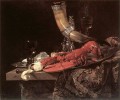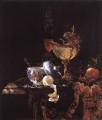Artists
Willem Kalf
- Country:
- Netherlands
- Birth year:
- 1619
- Death year:
- 1693
Willem Kalf (1619 Rotterdam-1693 Amsterdam) lived in France from 1640 to 1646. Upon his return he settled in Rotterdam, and after 1652 he lived in Amsterdam. Around 1680 Kalf gave up painting and was active as an art dealer for the rest of his life. In addition to individual landscapes and interiors with peasants, he painted almost exclusively still lifes. His early pictures drew from the work of Francois Ryckhals, who has also been suggested as Kalf's teacher, although no documentary evidence of this exists. In the 1650s Kalf began painting precious and decorative still lifes, which established his fame as one of the outstanding Dutch still-life artists. His early works seem rather stiff at times, but he developed a more variable style as time went on and expanded his repertoire of objects to incorporate valuable Chinese porcelain, silver tableware, Venetian glass, mother of - pearl vessels, selected fruit and Oriental patterns into his pictures. His still lifes present harmonious arrangements without becoming mannered. Some of is works are Still Life with Pilgrim's Bottle and Two golden Pitchers, 1643, Wallraf-Richartz-Museum, Cologne, Banquet with Nautilus Cup and Chinese Sugar Bowl, 1660, Museo Thyssen - Bornemisza, Madrid, and Banquet with Silver "Holbein Bowl", 1678, Statens Museum for Kunst, Copenhagen.





